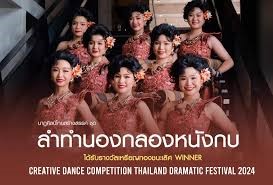Developing Learning Activities to Promote the Ability to Create Dance for Junior High School Students by Studying the Knowledge of Dance Teachers who Organize Creative Dance Activities in the Educational Institution Context
Main Article Content
Abstract
The objectives of this research are 1) to study knowledge from dance teachers who organize dance creative activities in the educational institution context, 2) to develop learning activities to promote the ability to create Thai dance for junior high school students by applying knowledge from dance teachers and 3) to seek the quality of the learning activities that are developed. The research methodology: Phase 1 studies knowledge from the activities organized by dance teachers, Phase 2 develops learning activities by applying the acquired knowledge, and Phase 3 examines the quality of the learning activity management. As for the target group, there are 5 dance teachers. The research tool includes a structured interview form and an assessment form for learning activity management. The research data were analyzed by interpreting and calculating the mean and standard deviation. The results of the research found that 1) The knowledge of dance teachers from organizing creative dance activities in the educational context has 3 significant principles: 1.1) Principles for promoting creative ability include selecting students, building basic knowledge, enhancing creative knowledge, organizing an experience, and creating works 1.2) Guidelines for promoting creative ability, arranging teams, dividing responsible persons according to their expertise 1.3) Strategies for promoting ability and increasing efficiency in creating Thai dance by joining to learn creativity and work on their own 2) The developed learning activities has 3 activities: 2.1) Build basic knowledge– such as dancing along with rhythm and lyrics, and interpreting the meaning of lyrics and dance moves, 2.2) Learn other people's creative work, analyzing concepts and consistency of the performance elements, 2.3) creativity by oneself and collaborating ideas to the work design in a unified manner, and 3) The quality of learning activities has been developed is at the highest level of = 4.58, S.D. = 0.54
Article Details

This work is licensed under a Creative Commons Attribution-NonCommercial-NoDerivatives 4.0 International License.
All authors must take public responsibility for the content of their paper. The WIPIT Journal Editors will not be taking any public responsibility for the content in the paper.
References
กรมส่งเสริมการปกครองท้องถิ่น. (2565). คู่มือการบริหารจัดการหลักสูตรสถานศึกษา ตามหลักสูตรแกนกลางการศึกษาขั้นพื้นฐาน พุทธศักราช 2551. (ม.ป.พ.).
กระทรวงศึกษาธิการ. (2551). หลักสูตรแกนกลางการศึกษาขั้นพื้นฐาน พุทธศักราช 2551. กระทรวงศึกษาธิการ.
ประไพลิน จันทน์หอม. (2559). การพัฒนารูปแบบการจัดการเรียนรู้เพื่อพัฒนาความสามารถในการถ่ายโยงองค์ความรู้ทางศิลปะของนักศึกษาศิลปศึกษา. [วิทยานิพนธ์ปริญญาดุษฎีบัณฑิต, จุฬาลงกรณ์มหาวิทยาลัย].
วรินทร์พร ทับเกตุ, พหลยุทธ กนิษฐบุตร, บวรนรรฏ อัญญะโพธิ์ และ เกสร เอมโอด (2567). การพัฒนากิจกรรมการเรียนรู้เพื่อส่งเสริมความสามารถในการสร้างสรรค์นาฏศิลป์ไทย สำหรับนักเรียนระดับมัธยมศึกษาตอนต้น โดยศึกษาจากองค์ความรู้ของครูผู้สอนนาฏศิลป์ที่จัดกิจกรรมสร้างสรรค์นาฏศิลป์ในบริบทสถานศึกษา. คณะศิลปศึกษา สถาบันบัณฑิตพัฒนศิลป์.
อุทัย ศาสตรา, ชาริณี ตรีวรัญญู และ ยุทธนา ฉัพพรรณรัตน์ (2562). กระบวนการเรียนการสอนเพื่อส่งเสริมความสามารถในการสร้างสรรค์ดนตรีไทย สำหรับนักเรียนระดับมัธยมศึกษาตอนต้น: การถอดบทเรียนจากศิลปินแห่งชาติ สาขาศิลปะการแสดง (ดนตรีไทย). วารสารครุศาสตร์ จุฬาลงกรณ์มหาวิทยาลัย, 47(2), 544 - 568. https://so02.tci-thaijo.org/index.php/EDUCU/article/view/196423/136549
อุบล ตู้จินดา. (2532). หลักและวิธีสอนศิลปะ. โอเดียนสโตร์.
อุษา สบฤกษ์. (2536). การศึกษาพฤติกรรมการสอนนาฏศิลป์ไทยในวิทยาลัยนาฏศิลป์.[วิทยานิพนธ์ปริญญามหาบัณฑิต, จุฬาลงกรณ์มหาวิทยาลัย]. Chulalongkorn University Intellectual Repository (CUIR). https://cuir.car.chula.ac.th/handle/123456789/75173


